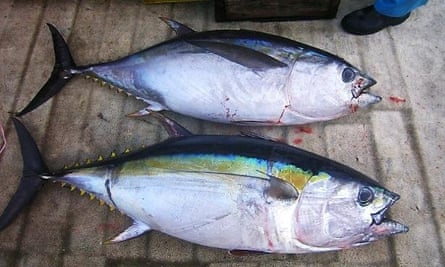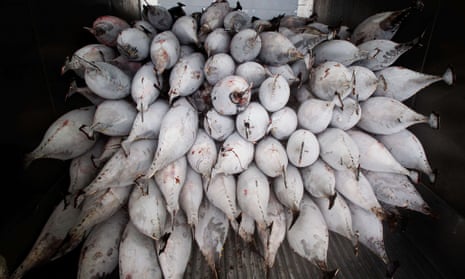In the warm waters of the western and central Pacific Ocean, fishing for tuna is transforming from an ancient art of hunting into a billion dollar video game.
Once the domain of native Islanders – who could discern terrestrial hues from the undersides of distant clouds, map their way through the seemingly endless ocean with the stars, and find aquatic life by studying the movement of seabirds – the Pacific is now bearing witness to a technology-driven race between companies to scoop up fish first.
Fish aggregating devices (FADs) are a fancy phrase for objects that have been used for centuries by commercial and artisanal fishermen to exploit the tendency of tuna to congregate around floating objects, such as coconuts, rafts or even dead whales.
To attract tuna, fishermen have long made their own floating objects – usually a large mass of net, rope, coconut fronds, and other rubbish that can float freely with the ocean’s current or be anchored to the seabed.
Today’s FADs resemble those of the past, but with some high tech additions. Now, they come with sonar and satellite buoys attached, which can tell the captain of a modern fishing vessel exactly what’s swimming underneath the objects from thousands of kilometers away.
In other words, FADs no longer simply complement a captain’s fish finding abilities. For many boats, they have become the prime tool in locating the fish. Mother Nature is no longer needed.
Before steaming towards a FAD to set a purse seine net, a vessel’s captain will already have an estimate on the biomass of fish held by the device, the particular species, and even the size of the fish – all picked up by sonar and transmitted via satellite.
As the use of FADs is increasing, conservation groups say existing measures to lower the impact aren’t working. Tech-equipped FADs are already playing a big role in the decimation of the bigeye tuna stock – a lucrative species sought in sushi restaurants from America to Europe to Asia – while also threatening the relatively healthy skipjack and yellowfin tunas, experts say.
“It’s an arms race,” says Bubba Cook, Pacific tuna program manager at WWF, formerly the World Wildlife Fund.
“The industry is spending a lot less time and a lot less money to track down the fish and actually conduct the fishing then they were 15 years ago,” he says. “In doing so, they are able to catch a lot more fish in a whole less time… that increase in efficiency is what’s driving the population of fish down.”
The battle’s epicenter
One particularly productive portion of the Pacific Ocean accounts for roughly 50% of global canned tuna supply. Stretching over 14.8m square kilometers of ocean, eight neighboring small Pacific Island states have joined forces through an arrangement called the Parties to the Nauru Agreement (PNA) to manage their abundant skipjack stocks.

PNA waters are home to some of the world’s richest fishing grounds, including a skipjack tuna fishery they estimate to be worth $8bn once the tins have passed through supermarket checkout counters. According to one estimate, 80,000 FADs are being used in PNA waters this year.
“The impact of sonar buoys, as stated by some of the industry players, is it is a game changer,” says Maurice Brownjohn, the PNA’s commercial manager.
“We have examples now where the captain is no longer allowed to know where his FADs are, because someone sits in a control room and says ‘go here make a set, go there and make a set’. The hunting instinct has gone out of it, and it’s purely a harvesting exercise … it’s cherry picking.”
To regulate fishing, the PNA jointly sells fishing days to distant fishing nations. With 24 hours of fishing costing as much as $12,000 recently, fishing companies are responding with a drive for efficiency, pulling more fish out of the water at faster and faster rates.
Urgent action needed to save bigeye tuna
Skipjack are believed to be a healthy stock, but there are concerns about whether they can sustain the FAD onslaught. What is known is bigeye tuna can’t.
Juvenile bigeye have a habit of joining skipjack at FADs and inadvertently getting caught in the nets.
Scientists have recently assessed bigeye stock at 16% of its historic size.
In addition to a need to slash catches in the bigeye longline fishery – where most of the fish is caught - the broader fishing community also recognizes urgent action is needed to regulate FADs to bring bigeye back from the brink.
A four-month ban on FADs already exists in the western and central Pacific, but is seen as ineffective at reducing bigeye mortality by the International Seafood Sustainability Foundation, as well as major environmental NGOs.
Failure of political talks in Samoa
NGOs want to see more action being taken. However, when it comes to fishing, competing political and commercial interests often see conservation measures fall deep into the abyss.
Compounding the problem, the small island states and big fishing nations involved in the management of the Pacific’s tuna fisheries can’t agree what to do about them.
Earlier this month, leaders from small Pacific island states and delegations from the European Union, China, South Korea, Japan, the US, and Taiwan – the “distant water” fishing nations – failed to agree on stricter conditions for FAD use in the region when they met at the annual meeting of the Westernand Central Pacific Fisheries Commission in Samoa, keeping in place the four-month ban for 2015.
The commission’s failure was met with widespread disappointment by Pacific region leaders and NGOs, including Greenpeace, which is calling for an outright ban on FADs.
“The data makes it absolutely clear that FADs have a devastating impact on juvenile bigeye, and unless the WCPFC declares a total ban on FADs, this meeting is just talk,” said Greenpeace’s Lagi Toribau at the WCPFC meeting in Samoa.
Conservationists strike back
In the absence of more comprehensive FAD management, conservationists and other stakeholders are calling for a resurgence in old-school fishing methods – the pursuit of free schools of skipjack, the only method recognized as sustainable by the Marine Stewardship Council.
But when it comes to monitoring, control and surveillance efforts, resource managers are also starting to turn to tech for help.
Working with The Pew Charitable Trusts, the PNA is developing a system that uses the same satellite technology used by FADs to track FADs. Eventually, it hopes the system will have the capability to track thousands of FADs floating in PNA waters and monitor each time a purse seiner sets its net on one.
Such a system could also help PNA countries lay down the law and follow the example of the United States, which fined Spanish fishing company Albacora SA $5m in 2010 after one of its vessels deployed FADs in US waters without a proper license.
“The urgent need for FAD management in the western and central Pacific is recognized by everyone, from scientists to industry,” says Amanda Nickson, Pew’s director of global tuna conservation.
“In the face of bigeye’s dramatic population decline in the region, it is inexcusable that there are no requirements for reporting or tracking where FADs are set into the water, how often they are used, and if the objects are ever recovered.”
Emmanuel Samoglou is a freelance writer.
The technology and innovation hub is funded by BT. All content is editorially independent except for pieces labelled “brought to you by”. Find out more here.

Comments (…)
Sign in or create your Guardian account to join the discussion